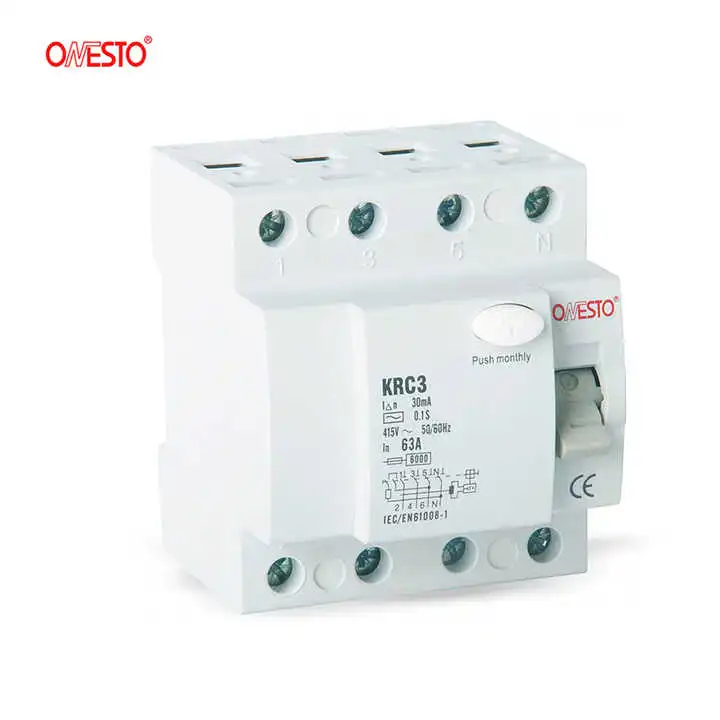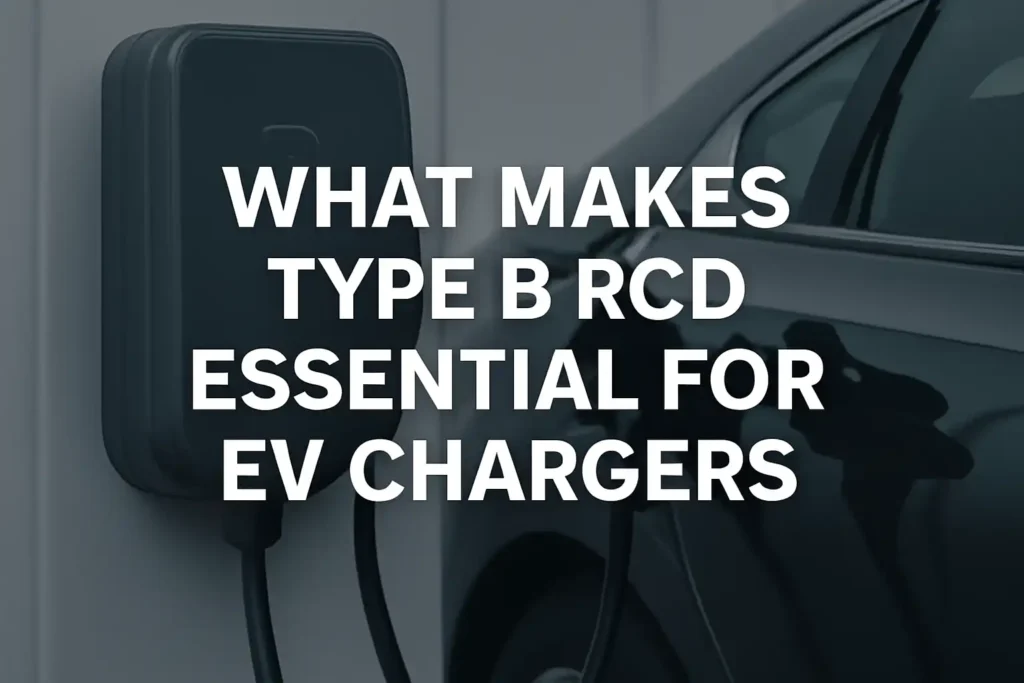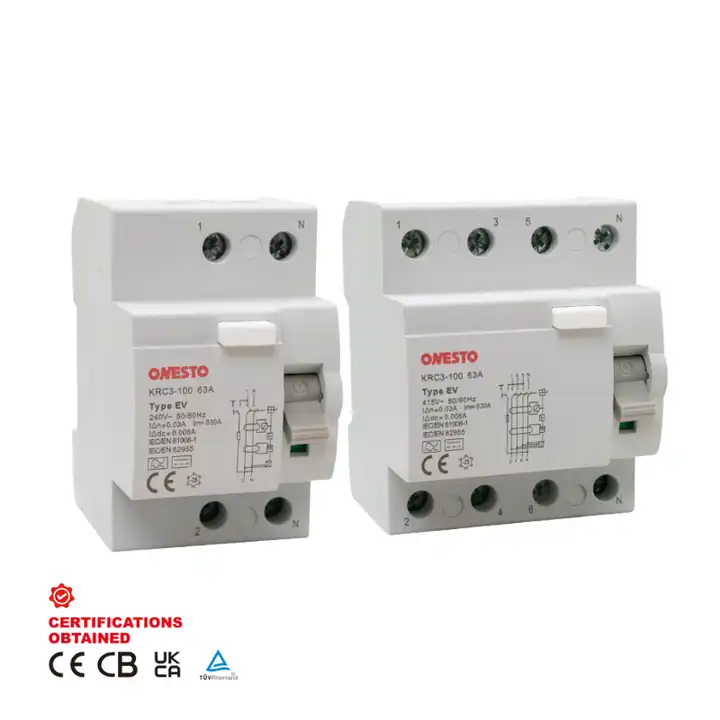Electric vehicle (EV) chargers need strong safety measures. These protect users and equipment. Type B RCD is important for this safety. It finds both AC and DC fault currents. This helps stop electrical dangers. It works well for EV chargers since cars can cause DC currents. Without it, these currents might not be noticed. Using this device lowers risks and makes systems safer. It also follows important safety rules.
Key Takeaways
- Type B RCDs are important for EV chargers. They find AC and DC currents to keep people safe from shocks.
- Testing and fixing RCDs often stops problems and helps them last longer. This makes things safer and less stressful.
- Using rules like IEC 61851 makes sure EV chargers follow safety laws and work well for users.
- Type B RCDs cost more at first but save money later. They stop damage and help meet safety rules.
- Always see if your EV charger has Type B RCDs. If it doesn’t, you need extra safety tools.
Understanding the Role of RCDs in EV Charging

What is an RCD?
An RCD is a device that keeps you safe. It stops electric shocks and lowers fire risks. It works by finding leaks in electrical currents. If it detects a problem, it shuts off the power fast. This quick action helps prevent harm or damage.
RCDs are very sensitive and notice small current changes. These changes are often tiny, measured in milliamperes. For example, a home RCD trips when it finds a leak of 30mA or more. This keeps you safe without cutting power too often.
Why are RCDs critical for EV chargers?
EV chargers work differently from regular devices. They can create both AC and DC current leaks. Without the right protection, these leaks might not be found. This could lead to serious safety problems.
RCDs help stop electric shocks and meet safety rules. Type B RCDs are best for EV chargers. They detect both AC and DC leaks, making them perfect for EV systems. In some countries, like Australia, RCDs are required for EV chargers to stay safe and follow laws.
Types of RCDs commonly used in electrical systems
There are different kinds of RCDs for different jobs. Here’s a simple table:
| Type of RCD | What It Detects | Where It’s Used |
|---|---|---|
| AC RCD | AC current leaks | Homes and offices |
| A RCD | AC and pulsing DC leaks | Devices like washers |
| B RCD | AC, pulsing DC, and smooth DC leaks | EV chargers and solar setups |
| F RCD | High-frequency leaks | Special drives and EV chargers |
Type B RCD is the most advanced. It handles all types of leaks. This makes it the best choice for EV chargers. It keeps systems safe and reliable in tough conditions.
Unique Features of Type B RCDs

Capabilities of Type B RCDs
Type B RCDs are special because they detect many current types. They find AC, pulsating DC, and smooth DC currents. This makes them useful for modern systems like EV chargers. They give strong protection from electrical problems.
These devices also have advanced features for better safety. They detect ground faults in both AC and DC systems. They check for leaks in DC systems and solar inverters. They trip at 6 mA DC and 30 mA AC, meeting global safety rules like IEC 62752. Their auto shut-off works fast when dangerous faults happen, keeping people safe.
Here’s a simple look at their abilities:
| Feature | What It Does |
|---|---|
| Ground fault detection | Finds faults in AC and DC systems. |
| DC system leak detection | Spots leaks in DC systems. |
| Solar inverter current detection | Tracks currents in solar systems. |
| AC/DC sensitivity | Detects AC and DC currents at low levels. |
| Shut-off trigger | Trips at 6 mA DC and 30 mA AC (IEC 62752). |
| Measurement accuracy | Measures with 0.2 mA precision. |
| Current range | Works with currents from 0 to 300 mA. |
| Auto shut-off | Stops power during dangerous faults (IEC 62752 or UL 2231). |
These features make Type B RCDs a great choice for EV chargers and advanced systems.
Comparison with Type A and Type AC RCDs
Type B RCDs are better than Type A and Type AC RCDs. Type AC RCDs only find AC current leaks. They work for simple places like homes. Type A RCDs find AC and pulsating DC leaks. They are good for appliances like washers. But neither can find smooth DC currents, which EV chargers often create.
Type B RCDs can detect all current types, including smooth DC. This makes them perfect for EV chargers, solar systems, and machines. Here’s a quick comparison:
| Feature | Type AC RCD | Type A RCD | Type B RCD |
|---|---|---|---|
| Finds AC currents | ✅ | ✅ | ✅ |
| Finds pulsating DC | ❌ | ✅ | ✅ |
| Finds smooth DC | ❌ | ❌ | ✅ |
| Good for EV chargers | ❌ | ❌ | ✅ |
Type B RCDs give the best protection, making them ideal for EV chargers.
Why Type B RCDs are Ideal for EV Charging
Type B RCDs are made for the needs of EV charging. EVs create smooth DC currents while charging. These currents can bypass Type A or Type AC RCDs, causing danger. Type B RCDs stop this by detecting smooth DC and cutting power quickly.
They also work well in tricky conditions. They handle AC currents up to 1000Hz and AC mixed with smooth DC. This keeps EV chargers safe and meets rules like IEC 61851 and IEC 62752.
Type B RCDs are also useful for solar systems and machines. They provide strong protection in many settings. Choosing Type B RCDs for EV chargers ensures safety, compliance, and peace of mind.
Regulatory and Safety Requirements for EV Chargers
Key international standards (e.g., IEC 61851, IEC 60364-7-722)
International rules help keep EV chargers safe and reliable. Two main standards, IEC 61851 and IEC 60364-7-722, explain what EV chargers need. They focus on using RCDs to find electrical leaks. This protects people from shocks and stops fires.
- IEC 61851: This rule ensures EV chargers are safe. It says RCDs must detect both AC and DC faults. It recommends Type B RCDs for busy places like public chargers, where risks are higher.
- IEC 60364-7-722: This rule is about setting up EV chargers. It requires RCDs to stop unusual currents. This keeps users and devices safe.
Following these rules helps your EV charger meet global safety standards. It also lowers risks and improves reliability.
National regulations mandating Type B RCDs
Many countries have laws about which RCDs to use in EV chargers. These laws depend on whether the charger already has DC fault protection. Here’s a simple guide:
| Requirement | Type of RCD | Condition |
|---|---|---|
| EV Charging Equipment | Type B | If the charger doesn’t have built-in DC fault protection |
| EV Charging Equipment | Type A or F | If the charger already has DC fault protection |
For example, in Europe and Australia, Type B RCDs are often required. These rules show that Type B RCDs are trusted to find all fault types.
Risks of non-compliance with safety standards
Not following EV charger safety rules can cause big problems. These include:
- Financial losses: Electrical faults can damage equipment and cost a lot to fix. Accidents can also lead to expensive lawsuits.
- Reputational damage: Ignoring safety rules can hurt your business image. Customers value safety and may lose trust in you.
- Legal penalties: Breaking safety laws can lead to fines or limits on your operations.
To avoid these issues, follow safety rules carefully. Using Type B RCDs shows you care about safety and meeting regulations.
Installation and Maintenance of Type B RCDs
Things to check before installation
Installing your RCD the right way is very important. You need to check both technical and environmental factors first. For example, the RCD must handle short-circuit currents up to 10,000 amps. This protects it from big electrical problems. Its IP20 rating means it blocks objects bigger than 12.5 mm. But it’s not safe for wet areas, so keep it dry. Always make sure it meets rules like IEC/EN 62423 and IEC/EN 61008-1. These rules ensure the RCD is safe and works well.
Here’s a simple table of these details:
| Specification | Details |
|---|---|
| Short-Circuit Current Capacity | 10 kiloamps (kA) – handles short-circuit faults up to 10,000 amps. |
| Protection Rating | IP20 – blocks objects over 12.5 mm, not for wet places. |
| Compliance with Standards | IEC/EN 62423 and IEC/EN 61008-1 – ensures safety and quality. |
How to maintain your RCD
Regular care keeps your RCD working properly. Test it often to make sure it trips during faults. Most makers suggest pressing the test button every month. This checks if the inside parts are working. Also, look at the wires for damage or rust. Broken or loose wires can make the RCD less effective. If you see problems, call an electrician right away. Keeping the RCD clean and dust-free also helps it last longer.
Costs and long-term benefits
RCDs may cost more at first, but they save money later. A good RCD lowers the chance of electrical problems. This avoids expensive repairs or broken equipment. Following safety rules also keeps you from getting fined. Over time, the safety and reliability of the RCD are worth the price. Picking the right RCD and taking care of it gives you safety and peace of mind.
Addressing Common Concerns About Type B RCDs
Are Type A RCDs good enough for EV chargers?
Type A RCDs are usually not good enough for EV chargers. They can find AC and pulsing DC currents but miss smooth DC currents. EV chargers often make smooth DC currents while working. If these currents are missed, they can pass through the RCD, causing safety risks.
For instance, charging an EV can create high-frequency currents. These come from switch mode power supplies (SMPS). These currents may cause “capacitive earth leakage currents.” Type A RCDs cannot handle these well. This makes them a poor choice for EV chargers, especially in places where safety matters most.
Is the price of Type B RCDs worth it?
Type B RCDs may cost more at first, but they are worth it. They find all types of current leaks, including smooth DC. This keeps users and devices safe. They also meet important safety rules like IEC 61851 and IEC 60364-7-722.
Type B RCDs stop unwanted tripping from high-frequency leaks. They trip only when needed, avoiding problems while staying safe. Over time, they save money by preventing repairs, fines, and damage to your reputation.
Do all EV chargers have built-in Type B RCDs?
Not all EV chargers have built-in Type B RCDs. Some only have basic protection, like Type A or Type F RCDs. These may not find smooth DC currents. In such cases, you need an extra Type B RCD for full safety.
For 3-phase EV chargers, Type B RCDs are strongly advised. They protect against DC current leaks, which are common in these systems. Always check your EV charger’s details to see if extra protection is needed.
Type B RCDs are key for safe EV charging systems. They find smooth DC currents that other RCDs miss. This matches the IEC 61851-1:2017 safety standard. They reduce risks like shocks from EV circuit harmonics. Installing them correctly and following rules keeps systems safe. It also ensures your EV charger works well and stays reliable.
FAQ
What happens if you use the wrong type of RCD for an EV charger?
Using the wrong RCD, like Type A or AC, is risky. It cannot detect smooth DC currents. This can lead to shocks or damaged equipment. Always pick a Type B RCD for full safety.
What makes Type B RCDs more reliable than other types?
Type B RCDs find all current types, even smooth DC. This helps them catch faults that others miss. Their advanced design makes them perfect for EV chargers. They ensure safety and work well in modern systems.
What should you check before installing a Type B RCD?
Make sure the RCD meets IEC/EN 62423 standards. Check it handles short-circuit currents up to 10,000 amps. Confirm its IP rating fits the environment. These steps ensure it works safely and properly.
What is the lifespan of a Type B RCD?
A Type B RCD can last over 10 years if cared for. Test it often and keep it clean. Follow the maker’s instructions to keep it working well and reliably.
What should you do if your Type B RCD trips frequently?
Frequent tripping may mean a system fault or RCD issue. Check the wiring and devices for problems. If it keeps happening, call an electrician to fix it.
The following information may be of interest to you
Which RCCB Type is Right for You? Type A vs Type B
Residual Current Circuit Breaker (RCD) and Leakage Protection
When is it necessary to use a 100mA residual current device
What You Need to Know About Commercial EV Charging Costs




